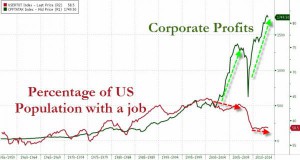
80% Of US Adults Are Near Poverty, Rely On Welfare, Or Are Unemployed
Despite consumer confidence at a six-year high, the latest AP survey of the real America shows a stunning four out of five U.S. adults struggle with joblessness, are near poverty, or rely on welfare for at least parts of their lives amid signs of deteriorating economic security and an elusive American dream. Hardship is particularly on the rise among whites, based on several measures. Pessimism among whites about their families' economic futures has climbed to the highest point since at least 1987.
“Poverty is no longer an issue of ‘them', it's an issue of ‘us',” as ‘the invisible poor' – lower income whites – are generally dispersed in suburbs (Appalachia, the industrial Midwest, and across America's heartland, from Missouri, Arkansas and Oklahoma up through the Great Plains) where more than 60% of the poor are white.
More than 19 million whites fall below the poverty line of $23,021 for a family of four – accounting for more than 41% of the nation's destitute – nearly double the number of poor blacks and as one survey respondent noted “I think it's going to get worse.”
…
Hardship is particularly on the rise among whites, based on several measures. Pessimism among that racial group about their families' economic futures has climbed to the highest point since at least 1987. In the most recent AP-GfK poll, 63 percent of whites called the economy “poor.”
…
“If you do try to go apply for a job, they're not hiring people, and they're not paying that much to even go to work,” she said. Children, she said, have “nothing better to do than to get on drugs.”
…
Economic insecurity among whites also is more pervasive than is shown in government data, engulfing more than 76 percent of white adults by the time they turn 60, according to a new economic gauge being published next year by the Oxford University Press.
…
“It's time that America comes to understand that many of the nation's biggest disparities, from education and life expectancy to poverty, are increasingly due to economic class position,” said William Julius Wilson, a Harvard professor who specializes in race and poverty.
…
“There is the real possibility that white alienation will increase if steps are not taken to highlight and address inequality on a broad front,”
…
“Poverty is no longer an issue of ‘them', it's an issue of ‘us',” says Mark Rank, a professor at Washington University in St. Louis who calculated the numbers.
…
Among the findings:
For the first time since 1975, the number of white single-mother households who were living in poverty with children surpassed or equaled black ones in the past decade, spurred by job losses and faster rates of out-of-wedlock births among whites. White single-mother families in poverty stood at nearly 1.5 million in 2011, comparable to the number for blacks. Hispanic single-mother families in poverty trailed at 1.2 million.
The share of children living in high-poverty neighborhoods — those with poverty rates of 30 percent or more — has increased to 1 in 10, putting them at higher risk of teen pregnancy or dropping out of school. Non-Hispanic whites accounted for 17 percent of the child population in such neighborhoods, up from 13 percent in 2000, even though the overall proportion of white children in the U.S. has been declining.
The share of black children in high-poverty neighborhoods dropped sharply, from 43 percent to 37 percent, while the share of Latino children ticked higher, from 38 to 39 percent.
Going back to the 1980s, never have whites been so pessimistic about their futures.

All this despite Jack Lew's insistence on this morning's Meet The Press that this recovery is ‘not anemic', six year highs in consumer confidence, and all-time-highs in US equity markets.
Perhaps it is worth reiterating the question that Rick Santelli asked before?



